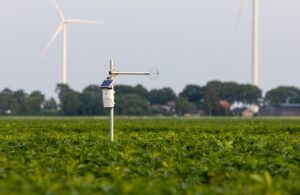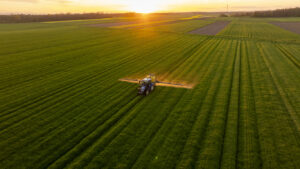Written by Gilly Kinsky, VP Marketing, CropX
Farmers used to schedule irrigation like clockwork. Every Tuesday, every Saturday, or whatever day fit their routine. They’d talk about weather forecasts, discuss general field conditions, and apply water based on calendar dates rather than actual crop needs. It was farming by schedule, farming by routine, farming by best guess.
That’s changing rapidly as real-time soil data becomes accessible through mobile apps.
Now farmers are checking their phones at breakfast, at lunch, and again after dinner – not just for weather updates or commodity prices, but for soil moisture data from their fields. They’re watching real-time numbers that tell them exactly what their crops need and when they need it.
“Once they start using the app they really enjoy looking at it and knowing where their levels are so they know when to apply,” explains John Krull from Farm-Tech Inc., who has witnessed this behavioral shift across multiple operations.
Across agriculture, farmers are developing what dealers call “app addiction” – a surprisingly positive behavioral shift that’s transforming both farming outcomes and business relationships.
The Death of “Water Wednesday”
For decades, irrigation scheduling followed predictable patterns. Farmers watered on schedule – “I run one time a week and this is the day I water” – regardless of what crops actually needed. It was efficient from a labor perspective, but incredibly wasteful from a resource perspective.
Calendar-based irrigation made sense when information was limited. Without real-time soil data, scheduled applications were the safest approach. Better to water too much than risk crop stress, even if it meant applying water when plants didn’t need it.
But this approach created expensive problems:
- Energy waste from running systems when plants couldn’t use additional water
- Nutrient leaching as excess water carried fertilizers below the root zone
- Disease pressure from overly wet field conditions
- Yield drag in areas prone to waterlogging
- Missed opportunities when crops needed water outside the normal schedule
The real cost wasn’t just the wasted inputs. It was the yields left on the table and the environmental impact of inefficient resource use.
When Farmers Get Hooked on Data
When farmers get access to real-time soil data, they stop farming by calendar and start farming by conditions. Farmers who previously watered every Tuesday are now applying irrigation based on actual soil moisture levels, plant needs, and weather conditions.
“Now they actually watch the app and only water when it’s calling for it,” notes Krull, who’s witnessed this transformation across multiple operations.
Instead of following predetermined routines, farmers are responding dynamically to field conditions. Instead of applying water defensively, they’re managing irrigation precisely. The results show up quickly in both resource efficiency and crop performance.
Why Apps Work When Reports Don’t
Agricultural technology has a long history of producing detailed reports that farmers rarely read. Binders full of soil test results, yield maps, and field analyses often gathered dust in farm offices. So why are apps different?
Apps deliver information when decisions need to be made, not weeks later when it’s too late to act. Real-time soil moisture data directly answers the question every irrigator faces daily: “Should I water today?” Good apps translate complex soil science into simple, actionable guidance that anyone can understand and act on.
Farmers can check field conditions from anywhere – the coffee shop, the equipment dealer, or home at dinner time. And seeing immediate results from data-driven decisions creates positive reinforcement that encourages continued use.
Proof in the Data
The real test of any agricultural technology comes at year-end when farmers evaluate what actually happened versus what was promised. This is where app-driven irrigation management proves its value most clearly.
“At the end of the year I meet with all of my Growers and we go through their reports and you can tell generally when the Growers are looking at the app and when they’re watering,” explains Krull. “When they do a good job and they water the way the app is supposed to be watered, you’ll see it at the end of the year and they’ll trend from top to bottom on the graph just the way that the water needs to be used.”
The data tells a clear story. Farmers who follow app recommendations consistently show specific patterns:
- More efficient water use throughout the season
- Better alignment between irrigation timing and actual plant needs
- Reduced total water applications without yield penalty
- “Most likely save a turn or two” compared to calendar-based schedules
- “Most of the time we do see a yield benefit just because they’re using everything efficiently,” according to Krull
This year-end validation creates a powerful cycle: better results lead to increased trust, which leads to more consistent app usage, which leads to even better results.
How Consultants Adapt
App adoption is changing how ag dealers or irrigation consultants add value. Instead of making routine scheduling decisions, they are becoming data interpreters, troubleshooters, and strategic advisors.
“CropX definitely makes my job easier, it makes it more streamlined. I’m managing multiple center pivots, multiple irrigation systems and clients throughout the year,” explains Rebecca Schubert. The app handles routine decision support, freeing consultants to focus on complex problem-solving and relationship building.
This shift benefits everyone. Farmers get immediate access to decision support without waiting for consultant availability, plus expert guidance when they need it most. Consultants can serve more clients effectively while focusing on high-value advisory services rather than routine scheduling tasks. Dealers build stronger relationships through technology that demonstrably improves farm performance and consultant effectiveness.
Beyond Irrigation
Farmers who become comfortable making data-driven irrigation decisions often become more receptive to data-driven approaches in other areas:
- Nutrient management based on soil test results rather than standard programs
- Planting decisions influenced by soil temperature and moisture data
- Pest management timed to field conditions rather than calendar dates
- Harvest timing optimized for crop moisture and weather windows
“We wanted something that Growers can log on, they can make a very quick decision about water management and it’s the done deal,” explains Schubert. That simplicity in one area often opens farmers’ minds to precision management approaches across their entire operation.
A New Standard
The shift from calendar-based to data-driven farming is a fundamental change in how farming decisions get made. As more farmers experience the benefits of app-driven irrigation management, expectations change for all agricultural technologies.
Farmers who’ve seen real results from real-time soil data become more demanding consumers of agricultural technology. They expect immediate access to actionable information. They want tools that make them more efficient, not just more informed.
This creates both opportunities and challenges for the broader agricultural technology industry. The bar for useful innovation keeps rising as farmers become more sophisticated users of data-driven decision support tools.
Why Engagement Matters Most
The most sophisticated agricultural technology in the world is worthless if farmers don’t use it consistently. The “app addiction effect” reveals that engagement matters more than features.
When farmers find themselves checking soil moisture data multiple times per day, making irrigation decisions based on real-time field conditions, and seeing clear results in their year-end performance reports, technology transforms from an expense to an asset.
For dealers and consultants, this behavioral shift represents a massive opportunity. Farmers who experience the benefits of data-driven decision making in one area become ideal customers for precision management approaches across their entire operation.
Help your customers move from guesswork to precision. With CropX, farmers make smarter irrigation decisions that boost yields, save resources, and build lasting loyalty.




